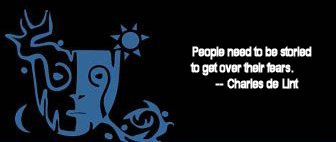|

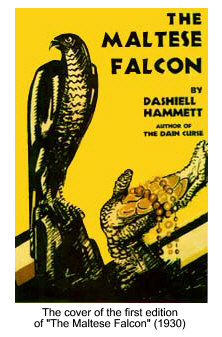 The Maltese Falcon The Maltese Falcon
and Ancient Myth
by John David Ebert
I.
Every noir narrative begins with a corpse, and in the present case, we are confronted with the dead body of one "Miles Archer," a man whom, we soon discover, was the partner of Sam Spade. Together, the pair ran a private detective agency in San Francisco, and as the narrative opens, they are retained by one Brigid O'Shaugnessy to investigate a man named Thursby. Brigid had come to Spade's office under the ruse that she was afraid her seventeen year old sister had run off with this Thursby and was anxious that Spade and Archer investigate. By the novel's conclusion, we learn that Brigid had approached Archer in a dark alley and murdered him with Thursby's gun, a British-made Webley revolver, in an attempt to frame Thursby for the murder. It turns out that she had wanted Thursby, who had been her business partner, out of the way, for both she and Thursby had been hired by a man named Gutman to obtain a golden falcon made by the Knights of Malta and given to Charles V of Spain as a gift during the seventeenth century. The falcon had made its way to Constantinople, where Brigid and Thursby had obtained it and then, instead of giving it to Gutman, had fled with it to Hong Kong, from whence, as the novel opens, it is on its way by boat to San Francisco.
Thus, like the Ark of the Covenant in Raiders of the Lost Ark, the black falcon is the central object of desire in Hammett's narrative, while Brigid is the central manipulator who has the male characters dangling on strings all about her. True to her namesake, Brigid is very much like a Celtic warrior heroine, comparable perhaps to Maeve in her ability to get men to do her bidding.
However, beneath the entertaining surface structures of Hammett's narrative — which is as smooth and streamlined as a fifties rocket-finned Chrysler — there lie some very interesting, and very ancient, deep structures organizing the narrative, structures which, when excavated, uncover the very bones of the noir narrative itself which here, with Hammett's novel, achieves its first true masterpiece.
Of course, The Maltese Falcon, published in 1930, was not the first detective story. It is a truism that Poe invented the genre with his three Dupin stories, which Wilkie Collins in the 1860's with The Woman in White and The Moonstone surpassed, and then Arthur Conan Doyle perfected with his famous Sherlock Holmes stories. But pipe-smoking Holmes, polite, suave and sophisticated, was a member of the upper classes whereas Sam Spade — and before him, Hammett's earlier alter ego, the Continental Op — is a man of the streets, as calloused and rough hewn as most of the denizens of the criminal underworld that he hunts. Spade is the prototype for every hard boiled detective which follows, from Chandler's Philip Marlowe to Robert B. Parker's Spenser. Unlike most of those other narratives, however, The Maltese Falcon is a true literary masterpiece, for its plot is perfectly formulated and its prose is lean and spare. Moreover, the mythic structures of The Maltese Falcon show us how the noir detective genre operates as a mythology of the modern megalopolis all its own, giving us a sort of West Coast parallel to the contemporary New York creation of the superhero.
II.
First, let's consider the names here before us (for names, when they are well chosen by their authors, can very often act as excellent points of departure for the literary archaeologist to proceed upon his excavations): 'Miles Archer' and 'Sam Spade.' Together they had formed a pair, running a private detective agency. Now, a spade is a tool used for digging into the earth, whereas an archer fires his arrows normally into the air, and sometimes — as in the case of ancient sieges — directly into the sky. 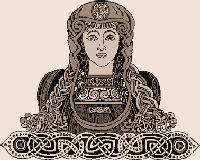 Thus, the names would seem to indicate a sort of heaven-earth dichotomy. Miles Archer, as we eventually discover, happens to have been murdered by Brigid O'Shaugnessy, whose first name is the same as that of an old Celtic fertility goddess, patroness of healing, poetry and the smithy. Her last name also seems significant, for it is the same as that of Michael O'Shaugnessy, one of the founding engineers of the city of San Francisco. Michael O'Shaugnessy built and designed the Hetch Hetchy aqueduct over controversy with environmentalists like John Muir, who resisted the industrializing of Hetch Hetchy, insisting that the beauty of the place deserved it to rank with the likes of Yosemite, and therefore ought to be left alone. Indeed, San Francisco (by contrast, say, with New York) was built out of a conflict between industrialists and environmentalists, and so Brigid's last name is a clue that she may have something to do with the fate of the city. Thus, the names would seem to indicate a sort of heaven-earth dichotomy. Miles Archer, as we eventually discover, happens to have been murdered by Brigid O'Shaugnessy, whose first name is the same as that of an old Celtic fertility goddess, patroness of healing, poetry and the smithy. Her last name also seems significant, for it is the same as that of Michael O'Shaugnessy, one of the founding engineers of the city of San Francisco. Michael O'Shaugnessy built and designed the Hetch Hetchy aqueduct over controversy with environmentalists like John Muir, who resisted the industrializing of Hetch Hetchy, insisting that the beauty of the place deserved it to rank with the likes of Yosemite, and therefore ought to be left alone. Indeed, San Francisco (by contrast, say, with New York) was built out of a conflict between industrialists and environmentalists, and so Brigid's last name is a clue that she may have something to do with the fate of the city.
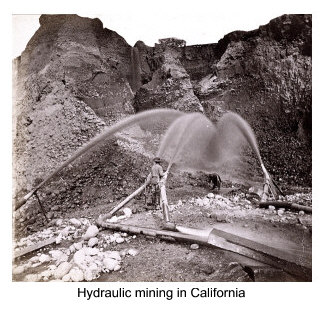 The Celtic goddess Brigid herself was a fertility goddess, and as such, was involved with the world of the farmer, who had to know her rhythms very well, indeed, in order to make a living from her bounty. However, in the history of the rise of San Francisco, farmers were the ones who lost out on behalf of the miners and engineers whose dams, aqueducts, timber mills and mines ruined his topsoils, robbed his water, and silted up his rivers. The run-off from mining projects like that of the Comstock Lode in Carson City, in which huge high pressure hoses (called "monitors") were used to wash away minerals from the sides of cliffs in order to reveal the treasures which they contained, caused particularly severe damage to farmer ecology by washing silt up rivers and making their water unusable for irrigation. In fact, the devastation wrought by industrial mining operations in the Central Valley between 1849 and 1884 was enormous: over 40,000 acres of farmland and orchards had been ruined and an additional 270,000 acres were severely damaged (Brechin, p. 50). Huge tunnels were torn into the earth in order to dump effluent into rivers like the Yuba. The waters of the Sacramento became so muddy that by 1852, salmon could no longer run in them. The course of hitherto placid rivers became subject to flash flooding. Debris was washed down into narrow canyons from mines, where it piled up. In addition, the raising of entire rivers out of their beds with the use of flumes required an enormous amount of lumber, deforesting huge swaths of earth in the process. The Celtic goddess Brigid herself was a fertility goddess, and as such, was involved with the world of the farmer, who had to know her rhythms very well, indeed, in order to make a living from her bounty. However, in the history of the rise of San Francisco, farmers were the ones who lost out on behalf of the miners and engineers whose dams, aqueducts, timber mills and mines ruined his topsoils, robbed his water, and silted up his rivers. The run-off from mining projects like that of the Comstock Lode in Carson City, in which huge high pressure hoses (called "monitors") were used to wash away minerals from the sides of cliffs in order to reveal the treasures which they contained, caused particularly severe damage to farmer ecology by washing silt up rivers and making their water unusable for irrigation. In fact, the devastation wrought by industrial mining operations in the Central Valley between 1849 and 1884 was enormous: over 40,000 acres of farmland and orchards had been ruined and an additional 270,000 acres were severely damaged (Brechin, p. 50). Huge tunnels were torn into the earth in order to dump effluent into rivers like the Yuba. The waters of the Sacramento became so muddy that by 1852, salmon could no longer run in them. The course of hitherto placid rivers became subject to flash flooding. Debris was washed down into narrow canyons from mines, where it piled up. In addition, the raising of entire rivers out of their beds with the use of flumes required an enormous amount of lumber, deforesting huge swaths of earth in the process.
In 1878, farmers and townsfolk were forced to form an Anti-Debris Society in order to counter the Hydraulic Miners' Association. In 1884, Judge Lorenzo Sawyer issued a permanent injunction against any further dumping by the North Bloomfield Mining Company. But then the Army Corps of Engineers, with the stated aim of making the Central Valley safe for farmers, simply finished off the process of devastation, for "they transformed large stretches of its rivers into sterile ditches, annihilating whatever native plants and animals had managed to survive the initial onslaught of mechanical exploitation. Engineers successfully transformed California's Great Central Valley into one of the most intensively managed and artificial landscapes in the world." (Brechin, p. 51).
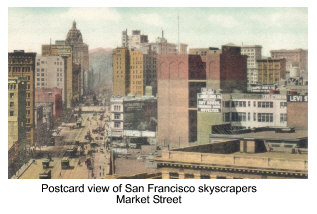 Indeed, the skyscrapers of San Francisco which line Market Street and created a concrete canyon out of Montgomery Street to the north (Montgomery and Market cross at right angles) were built and paid for out of fortunes made by these very same mining operations. The plundering of the earth and the desire to escape from it into high rises is tantamount to a proclamation of war upon the environment and all that lives in it, from farmers and ranchers to animals and plants, and so, upon the larger organism of Gaia herself. Even the cable cars which are such an icon of San Francisco today were themselves made possible by developments in the technology of mining, for the system of cables which they depend upon were invented by Andrew Hallidie, who in 1857 founded the California Wire Rope and Cable Company in which he used wire rope to carry ore skips across canyons on aerial tramways. In the 1860's, he and engineer Benjamin Brooks transformed this system into one in which passenger cars were pulled by an endless ropeway running in a slot beneath the street. The cable cars made it possible for pedestrians to access San Francisco's hilltops more easily, thus opening up a new real estate market on these previously inaccessible areas. (Brechin, p. 65). Indeed, the skyscrapers of San Francisco which line Market Street and created a concrete canyon out of Montgomery Street to the north (Montgomery and Market cross at right angles) were built and paid for out of fortunes made by these very same mining operations. The plundering of the earth and the desire to escape from it into high rises is tantamount to a proclamation of war upon the environment and all that lives in it, from farmers and ranchers to animals and plants, and so, upon the larger organism of Gaia herself. Even the cable cars which are such an icon of San Francisco today were themselves made possible by developments in the technology of mining, for the system of cables which they depend upon were invented by Andrew Hallidie, who in 1857 founded the California Wire Rope and Cable Company in which he used wire rope to carry ore skips across canyons on aerial tramways. In the 1860's, he and engineer Benjamin Brooks transformed this system into one in which passenger cars were pulled by an endless ropeway running in a slot beneath the street. The cable cars made it possible for pedestrians to access San Francisco's hilltops more easily, thus opening up a new real estate market on these previously inaccessible areas. (Brechin, p. 65).
Although this passage may seem like a street that leads us nowhere, in fact, by paying close attention to the graffitti on the walls of this street, we can begin to build a context of associations in which Brigid O'Shaugnessy's murder of Miles Archer can be understood as tracings embedded within a larger pattern. For Miles Archer, as his name suggests, embodies the heavenly aspect of the pair that he forms with Sam Spade, and so he is the skyscraping tendency of the city founders which, in Hammett's narrative, is caught, checked and overthrown by the old rustic goddess of the earth herself in disguise as a femme fatale. And Sam Spade, the digger into the earth — as well as into the lives of his clients — is essentially the mining magnate whose various metallurgical operations made his partner's ascension to the heavens possible.
Thus, Hammett's private detective heroes, from the Continental Op to Sam Spade, are the immune system of San Francisco itself, for their values are precisely those of the city: nomadic, rootless, misogynistic; lonely bachelors whose very existence is a refutation of the old agrarian institution of marriage itself. It is Spade's job (mythologically speaking) to identify those underworld criminals whose values are at odds with the city's and to return them back to Hades where they belong.
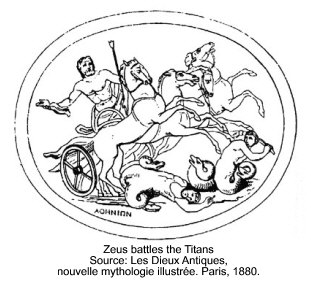 As in the Greek myth recounted by Hesiod, in which the angry Gaia sends her brood of Titans and Giants to war against the heaven-dwelling god Zeus — comfortably ensconced in his skyscraping residence atop Mount Olympus — so in Hammett's novel, the goddess brings with her denizens from the underworld, denizens who are eager to capture Zeus's eagle. Gutman, for instance, the kingpin who has hired Thursby and Brigid to find the falcon for him, is essentially the chthonic serpent in disguise (a snake, remember, is merely a traveling "gut"). He weighs over 300 lbs. and visually resembles Jabba the Hut (in John Huston's film, anyway), although with respect to his function in the story, he is morphologically homologous to Fafnir in Wagner's Ring cycle, the giant who takes the gold as payment from the gods for building Valhalla, but is corrupted by its sinister power and turned into a greedy dragon. If the falcon, then, is the heavenly principle, Gutman is the resentful serpent who, like the nagas of Indian mythology, are forever cursing their antagonist, the solar bird Garuda. Gutman and his band of criminals are the dispossessed heroes of the underworld who, in an uneasy alliance with the offended goddess, wish to have their gold back, like Alberich in Der Ring des Nibelungen who wishes to take back the gold that was stolen from him but which he in turn took from the Rhinemaidens. As in the Greek myth recounted by Hesiod, in which the angry Gaia sends her brood of Titans and Giants to war against the heaven-dwelling god Zeus — comfortably ensconced in his skyscraping residence atop Mount Olympus — so in Hammett's novel, the goddess brings with her denizens from the underworld, denizens who are eager to capture Zeus's eagle. Gutman, for instance, the kingpin who has hired Thursby and Brigid to find the falcon for him, is essentially the chthonic serpent in disguise (a snake, remember, is merely a traveling "gut"). He weighs over 300 lbs. and visually resembles Jabba the Hut (in John Huston's film, anyway), although with respect to his function in the story, he is morphologically homologous to Fafnir in Wagner's Ring cycle, the giant who takes the gold as payment from the gods for building Valhalla, but is corrupted by its sinister power and turned into a greedy dragon. If the falcon, then, is the heavenly principle, Gutman is the resentful serpent who, like the nagas of Indian mythology, are forever cursing their antagonist, the solar bird Garuda. Gutman and his band of criminals are the dispossessed heroes of the underworld who, in an uneasy alliance with the offended goddess, wish to have their gold back, like Alberich in Der Ring des Nibelungen who wishes to take back the gold that was stolen from him but which he in turn took from the Rhinemaidens.
Where is this underworld located to which Spade is attempting to return these criminals? On a map of San Francisco, this turns out to be the underworld that is located to the south east of Market Street, the old industrial and factory areas of the working classes where crime and poverty are part of daily life. Hammett's noir heroes try to keep the criminal incursions into the upperworld north of Market Street at a minimum, for north of Market, and along the spinal axis of Montgomery leading clear down to North Beach, lies the business district where most of his narratives take place. It is a fitting coincidence, then, that the North is traditionally the direction of the mythological upper classes: the abode of Zeus upon Mount Olympus, or Mt. Meru in the Himalayas; whereas the South, as in Vedic myth, is normally the direction of the underworld and of ghosts and spirits, as in the case of Crete vis a vis the Greek mainland (over which King Minos ruled as Lord of the Dead), or in The Ramayana, Sri Lanka, the island to which Sita is abducted by the evil demon Ravana, or in the Mesopotamian Gulf, the land of Dilmun which, identified with the island of Bahrein, seems to have been a necropolis to which the northern dead sojourned and over which Utnapishtim, in the Gilgamesh Epic, was given jurisdiction.
Thus, the private detective hero created by Dashiel Hammett in San Francisco is a sort of East Coast equivalent to the comicbook superhero of New York City which, as I have shown in Celluloid Heroes & Mechanical Dragons, emerged as a kind of immune cell to keep that city free of monsters and demons. But there is a crucial difference between these two types of heroes . . .
III.
. . . for New York was the center of the radio industry, and the effects of radio essentially brought the comicbook superhero into being as an oral tribal warrior who solves problems in exactly the same way that they are solved in primary oral epics like the Iliad and the Kalevala, namely, through physical deeds of grand violence. A flip through the glossy pages of any of Frank Miller's graphic novels will confirm that they are blood-soaked throughout.
But the noir detective is different from the comicbook superhero in that he does not triumph over his villains through physical violence — although on occasion he does resort to this — but rather solves his problems by means of ratiocination. (Note that the hero of Hammett's The Glass Key , Ned Beaumont, who is smarter than everyone else around him, triumphs over his adversaries not with violence, which he is no good at, but by constantly outwitting everyone. He is the clever, wily, mercurial Odyssean type of hero which, in fact, is the archetype of the noir detective.) The noir hero is essentially an intellectual problem-solver, for like Oedipus, he slays dragons through the power of the word rather than the sword. And, like Oedipus, he is normally presented with a riddle which he must solve, normally the inexplicable presence of a corpse which someone hires him to explain. Through the application of his mercurial intellect, he must go backward in time and reconstruct the sequence of causes that led up to the effect embodied by the corpse. Thus, he gathers up the component pieces like the separate frames of a strip of celluloid, and by the narrative's conclusion, projects them forth into a running narrative. The solutions are linear structures, produced by the power of sequential thinking, the same kind of thinking that went into the analysis of physical motion through space via analytical geometry. The hero solves his crimes through the application of logic and reason, exactly duplicating the manner in which the scientist arrives at his conclusions by testing a hypothesis. The private detective is thus a vestigial survival into the popular, low resolution medium of the mystery novel of the very kinds of linear thinking which that medium helped to obsolesce. , Ned Beaumont, who is smarter than everyone else around him, triumphs over his adversaries not with violence, which he is no good at, but by constantly outwitting everyone. He is the clever, wily, mercurial Odyssean type of hero which, in fact, is the archetype of the noir detective.) The noir hero is essentially an intellectual problem-solver, for like Oedipus, he slays dragons through the power of the word rather than the sword. And, like Oedipus, he is normally presented with a riddle which he must solve, normally the inexplicable presence of a corpse which someone hires him to explain. Through the application of his mercurial intellect, he must go backward in time and reconstruct the sequence of causes that led up to the effect embodied by the corpse. Thus, he gathers up the component pieces like the separate frames of a strip of celluloid, and by the narrative's conclusion, projects them forth into a running narrative. The solutions are linear structures, produced by the power of sequential thinking, the same kind of thinking that went into the analysis of physical motion through space via analytical geometry. The hero solves his crimes through the application of logic and reason, exactly duplicating the manner in which the scientist arrives at his conclusions by testing a hypothesis. The private detective is thus a vestigial survival into the popular, low resolution medium of the mystery novel of the very kinds of linear thinking which that medium helped to obsolesce.
Hammett's San Francisco, however, was not a newly literate polis, but rather a new city built within a culture in which the values of literacy were beginning to be eroded by popular narratives like the very ones in which the literate values of the noir detective were celebrated. This is perhaps why the noir narrative disintegrated as the twentieth century unspooled, and the values of popular culture, with its image worship and its mythological icon-based revival triumphed over the values of the Gutenbergian world of literacy. By the 1960's noir — at least in film — was a dead genre, while that of the comic book superhero, invented at about the same time during the 1930's, was just getting warmed up. For the superhero has nothing to do with literacy, and in proportion to the decline of literacy, he has become more and more popular, while the noir hero has been relegated to the rubbish heap of nostalgia for old black and white reruns watched by granddad — with his pre-television attention span — in the back room.
Every noir narrative, as I have said, begins with a corpse. Then it moves backward through an analysis of the causes that brought this particular effect — i.e. death — into being. The image of a corpse laid out on a slab for deposition is where the Christian mythos ends, but this very same image is merely the beginning of the noir narrative. Thus Arnold Bocklin's painting "Mary Magdalene Mourning Over the Body of Christ," painted in 1867 at about the same time as Wilkie Collins was writing the first detective novels, is the annunciation for the coming of the detective genre. Thus, as in the case of Western science, which emerged largely out of the study of dead bodies, it is a corpse which becomes the inspiration for the activation of analytical thought. And just as all higher thought originated, perhaps, with the problem of death, with the apprehension of the thereness of a corpse, so too, the linear thought structures of the noir narrative begin to march forth from a meditation upon death. There is, thus, a secret inward relation between death and literacy.
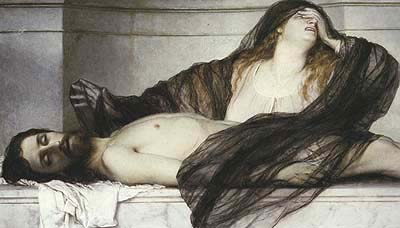
A corpse is something that is wholly space and no longer has any relation to time. The written word, likewise, in being divorced from the context of its evanescent uttering, no longer flows through time, but is something that has become. Words on a page, that is to say, only occupy physical space until they are animated — that is, put through the temporal flow — by the application of human thought. The Egyptians seem to have been the first to understand this, for the earliest origins of writing in Egypt come from tombs. Furthermore, the Egyptian god of writing, Thoth (whose name, perhaps, prefigures the word "thought"), was the premier god of the dead responsible for guiding souls to the underworld.
Without writing, and especially without printed writing, linear thought would not exist, for in pre-literate cultures thought is never analytical but something totalistic, for it exists in an acoustically resonant cavern space from which images bounce back and forth like sonic echoes, but within which they exist as separate and disconnected things, like an animal on the wall of a Paleolithic cave occupying its own private space and having no relation to the other animals as a whole. 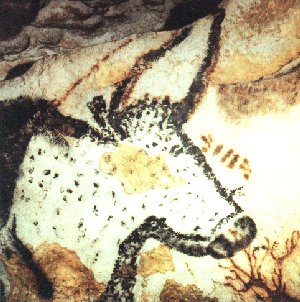 Cartesian phase space, on the other hand, is an intensely visual space, created by a linear, print-based mentality which is accustomed to scanning words from left to right on a printed page. It just so happens that this kind of linear process is the same kind of thinking that goes into the building of complex machinery, for machines must be carefully assembled step by step, not all at once. Sequence is of the essence of both machinery and literacy. Cartesian phase space, on the other hand, is an intensely visual space, created by a linear, print-based mentality which is accustomed to scanning words from left to right on a printed page. It just so happens that this kind of linear process is the same kind of thinking that goes into the building of complex machinery, for machines must be carefully assembled step by step, not all at once. Sequence is of the essence of both machinery and literacy.
So, in the detective genre, there is a distant echo of all of this in the association between the analysis of the corpse as effect, as a sort of text, in other words, and the noir detective as a sort of scholar (or scientist) investigating how this particular text came to be written. The point being, here, that the noir detective is an embodiment of the values of the literate, urban and highly mechanized city, such values being the very opposite, not only of those of the post-literate secondary orality of electronic society, but also of those of the female, the right brain, the image, context, environment and embeddedness of every kind. Hence, Leonard Shlain's insight in The Alphabet vs. the Goddess that the revival of the goddess is connected with the decline of literacy is absolutely correct. And correct, also, then, was Sam Spade's intuition that the woman named Brigid standing before him was a threat to his whole way of life.
 Thus, the narrative of The Maltese Falcon is an assertion of the values of the city over against those of the countryside — as well as of hearth and domesticity — just as Zeus, in Greek myth, represents the values of urban, rational — and literate — Athens, against the ancient Pelasgian and Boeotian earth cults of the farmers. Athena, the official patron of the city, presides over the case of the matricidal Orestes in Aeschylus, and it is with Orestes that she sides against the ancient, bloodthirsty matriarchal Furies of Mother Right and the older, more chthonic Justice of the rural countryside. These very same structures are reiterated time and again in the archetypal noir narrative, in which the hero triumphs over a femme fatale. (James M. Cain's novel Mildred Pierce, on the other hand, is the direct antithesis of The Maltese Falcon, for it celebrates precisely the values which that novel rejects: the independent woman, the suburbs, marriage, the sphere of the domestic, children, etc.) Thus, the narrative of The Maltese Falcon is an assertion of the values of the city over against those of the countryside — as well as of hearth and domesticity — just as Zeus, in Greek myth, represents the values of urban, rational — and literate — Athens, against the ancient Pelasgian and Boeotian earth cults of the farmers. Athena, the official patron of the city, presides over the case of the matricidal Orestes in Aeschylus, and it is with Orestes that she sides against the ancient, bloodthirsty matriarchal Furies of Mother Right and the older, more chthonic Justice of the rural countryside. These very same structures are reiterated time and again in the archetypal noir narrative, in which the hero triumphs over a femme fatale. (James M. Cain's novel Mildred Pierce, on the other hand, is the direct antithesis of The Maltese Falcon, for it celebrates precisely the values which that novel rejects: the independent woman, the suburbs, marriage, the sphere of the domestic, children, etc.)
Indeed, in any given Hammett novel or short story, we can almost always be certain that a woman, somewhere, is to blame for the murder or murders with which his stories and novels begin. The woman in "The House on Turk Street," for instance, who manipulates three men into fighting for her and killing each other; or the character of Dinah Brand in Red Harvest, who is always in complicity with the novel's criminals; or the crazy women in The Dain Curse, Aaronia Haldorn or Alice Dain, who are guilty of murder and manipulation. Women, in Hammett's novels, are always at the root of the evils perpetrated, and they are in league with the criminals, because the criminals are the Titans, giants and monsters of his narratives, the underworld beings who are in alliance with Gaia, and who wish to overthrow the ruling city's power structures so that they can erect their own shadow economy of trade in crime. Notice that in Hammett's stories, his villains are always deformed somehow: the kid who barely talks above a whisper in Red Harvest; or the kid with a lisp in "The Whosis Kid"; or the deformed, inhuman ears of Gabrielle Dain in The Dain Curse; they always have limps, scars, stutters — like Walter Ivans in The Glass Key-and this not only marks them as physiognomically inferior and therefore criminal, but is in fact a distinguishing mythological trademark of underworld beings.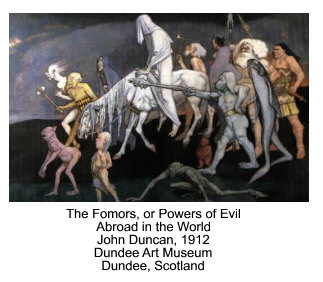 In Irish mythology, for instance, the Fomorii who are the equivalent to the Titans of Greek myth, are all deformed: they have one eye, one leg or arm, or some other such monstrosity; and the same goes for the Titans of Greek myth and the rakshasas of Hindu myth. Underworld heroes tend towards physical deformity, for they embody the values of chaos in opposition to the harmony and orderliness of urban life in cities which, in clearing the trees and draining the swampy habitats of the countryside, make civilized life possible. Likewise, the transformation of the scarcely inhabitable desert peninsula upon which the city of San Francisco was built and made possible through the construction of aqueducts which brought life-revivifying water into the city, also erected a miniature cosmos by displacing and triumphing over a wilderness. The criminals in the underworlds of Hammett's novels are the very human equivalents of the chaotic wilderness displaced by the city and so they must be kept out of the city at all costs. In Irish mythology, for instance, the Fomorii who are the equivalent to the Titans of Greek myth, are all deformed: they have one eye, one leg or arm, or some other such monstrosity; and the same goes for the Titans of Greek myth and the rakshasas of Hindu myth. Underworld heroes tend towards physical deformity, for they embody the values of chaos in opposition to the harmony and orderliness of urban life in cities which, in clearing the trees and draining the swampy habitats of the countryside, make civilized life possible. Likewise, the transformation of the scarcely inhabitable desert peninsula upon which the city of San Francisco was built and made possible through the construction of aqueducts which brought life-revivifying water into the city, also erected a miniature cosmos by displacing and triumphing over a wilderness. The criminals in the underworlds of Hammett's novels are the very human equivalents of the chaotic wilderness displaced by the city and so they must be kept out of the city at all costs.
Thus, Brigid O'Shaugnessy kills Miles Archer because she is the equivalent of the bloodthirsty Furies who wish to exact vengeance on behalf of crimes against Mother Right. She is the dark chthonic cavern world of ancient night which was pierced and broken open by the rocket-like spires of Western European cathedrals and American skyscrapers. So the upward straining vector of modern urban society is deflected by her and thrown down. This countermove on behalf of the goddess against patriarchy is what sets the narrative of The Maltese Falcon in motion.
IV.
The falcon is a bird that was, in ancient Egypt, associated with kingship. It was the symbol of the sun god Horus, the god which every living pharaoh incarnated, for the pharaoh had inherited his throne by way of Mother Right, since his claim to sovereignty was based on his genealogy through the female, not the male. In ancient Mesopotamia likewise, before the coming of the Babylonians, the paraphernalia of kingship — along with the right to rule — were bestowed on the king by a goddess, Inanna, who is depicted in numerous works of art bestowing upon him the rod and the ring of rulership. Inanna's bird, furthermore, was the dove, while Athena's was the owl, Aphrodite's the goose, and Brigid's the white swan. So, in the earlier traditions, birds were almost always sacred to goddesses, for as Robert Graves in The White Goddess has shown, it was later patriarchal divinities who came and took the bird iconography away from them, for Celtic Bran took his raven from the goddess Dana, as Odin took his two ravens from Freya, and as Apollo took his raven from Athena. has shown, it was later patriarchal divinities who came and took the bird iconography away from them, for Celtic Bran took his raven from the goddess Dana, as Odin took his two ravens from Freya, and as Apollo took his raven from Athena.
The falcon in Hammett's narrative is then an ancient symbol of kingship and of the power of the goddess to confer it upon whomsoever she chose (recall that Hammett's falcon was made by the Knights of Malta, for the island of Malta was once, way back in the later Neolithic, one of the great strongholds of goddess iconography and religion). Originally, it would have been Brigid's right to bestow it upon whomever she chose to put upon the throne. In this case, her choice would seem to have been Sam Spade, but Spade will have none of that, just as the  Babylonians rejected the theory of bestowal of kingship by the goddess and so changed the old Sumerian stories in which Gilgamesh was Inanna's paramour into an epic in which he specifically rejected her advances. As in the case of the death of Spade's sidekick Miles Archer, in the Gilgamesh narrative, likewise, we recall that it was the goddess who there caused the death of the male buddy Enkidu when Inanna, after being spurned by Gilgamesh, asked the gods to strike his companion down with a mortal illness. We note, too, the similarity of the climactic confrontation between Sam Spade and Brigid O'Shaugnessy with Gilgamesh's clash with Inanna, for Spade, too, refuses to play the role of one of her sacrificial lovers. He says, "I won't play the sap for you," in reference to the deaths of the various men she has brought about, beginning with Miles Archer on down to Captain Jacobi. He knows what fate such a role would require of him, just as Gilgamesh accused Inanna of the deaths and misfortunes of a whole litany of her lovers. Spade, likewise, will not be put on the throne as king of the city — for he mistrusts authority figures, anyway — but most certainly not by any mere woman, anymore than Gilgamesh, the Babylonian tribal hero, will agree to play the role of Inanna's paramour Dumuzi, whose fate is merely to die and be reborn through her womb. Babylonians rejected the theory of bestowal of kingship by the goddess and so changed the old Sumerian stories in which Gilgamesh was Inanna's paramour into an epic in which he specifically rejected her advances. As in the case of the death of Spade's sidekick Miles Archer, in the Gilgamesh narrative, likewise, we recall that it was the goddess who there caused the death of the male buddy Enkidu when Inanna, after being spurned by Gilgamesh, asked the gods to strike his companion down with a mortal illness. We note, too, the similarity of the climactic confrontation between Sam Spade and Brigid O'Shaugnessy with Gilgamesh's clash with Inanna, for Spade, too, refuses to play the role of one of her sacrificial lovers. He says, "I won't play the sap for you," in reference to the deaths of the various men she has brought about, beginning with Miles Archer on down to Captain Jacobi. He knows what fate such a role would require of him, just as Gilgamesh accused Inanna of the deaths and misfortunes of a whole litany of her lovers. Spade, likewise, will not be put on the throne as king of the city — for he mistrusts authority figures, anyway — but most certainly not by any mere woman, anymore than Gilgamesh, the Babylonian tribal hero, will agree to play the role of Inanna's paramour Dumuzi, whose fate is merely to die and be reborn through her womb.
So the struggle over the black falcon in Hammett's narrative is, on one level, a struggle for mythological rulership over the city of San Francisco. The golden bird which has fallen into a black enamel casing over the years is a fitting image of the staining of spiritual values by the coarsely motivated economic interests of the modern day. The criminals, Gutman, Wilmer and Joel Cairo want the bird because they believe it is worth money, and so their motives are purely avaricious, but from a mythological point of view, Gutman, as we have seen, is the serpent in disguise, and he actually wants revenge against his age-old nemesis the solar bird. Brigid, the old bird goddess in disguise as a femme fatale, wants the bird back because it is her rightful totem that has been taken away from her by patriarchal city builders. And Spade, the literate — and hence, anti-iconic — hero of the modern megalopolis, wants rid of all these mythic beings — birds, snakes, goddesses and all — for he is an extension of the immune system of the city of San Francisco itself.
The climax of the story, in which Spade reveals Brigid for the conniving murderess she really is, brings the narrative to its point, for Brigid is revealed from the misogynist's point of view as unworthy of possessing the right to rule the modern megalopolis, which is based on rational, literate values, and not upon the old mythological blood logic of lex talionis. She must be returned to her place in the underworld of Tartarus, and so in John Huston's film adaptation, the last shot, fittingly, shows Brigid being turned over to the authorities, placed in an elevator, and sent downward. She has been sent packing off to the underworld because the city must not be ruled by beings out of ancient myth, since such beings are right brain creations and belong to the realm of the image which the left brain, with its linear linguistic structures, has displaced. The goddess, with her entourage of dwarves and Jabba-the Hut style fatmen, must be sent away by the civic hero as defender of the literate values of a rational polis.
Works Cited
Brechin, Gray. Imperial San Francisco: Urban Power, Earthly Ruin. Berkeley, CA: University of California Press, 2001.
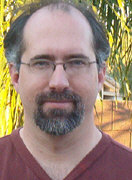 John David Ebert is a former editor for the Joseph Campbell Foundation. He wrote footnotes for Baksheesh & Brahman, Sake & Satori and The Mythic Dimension, all posthumous publications of Campbell's writings. His first book was Twilight of the Clockwork God: Conversations on Science and Spirituality at the End of an Age John David Ebert is a former editor for the Joseph Campbell Foundation. He wrote footnotes for Baksheesh & Brahman, Sake & Satori and The Mythic Dimension, all posthumous publications of Campbell's writings. His first book was Twilight of the Clockwork God: Conversations on Science and Spirituality at the End of an Age (Council Oak Books, 1999). His most recent book is entitled Celluloid Heroes & Mechanical Dragons: Film as the Mythology of Electronic Society
(Council Oak Books, 1999). His most recent book is entitled Celluloid Heroes & Mechanical Dragons: Film as the Mythology of Electronic Society (Cybereditions, 2005), and was reviewed by Dr. William Doty in the August 2005 issue of Mythic Passages. His work has been published in various periodicals such as Utne Reader, The Antioch Review, Lapis and Alexandria. He is currently working on a book about popular culture and mythology, tentatively entitled Electric Demigods of the Lightspeed World. (Cybereditions, 2005), and was reviewed by Dr. William Doty in the August 2005 issue of Mythic Passages. His work has been published in various periodicals such as Utne Reader, The Antioch Review, Lapis and Alexandria. He is currently working on a book about popular culture and mythology, tentatively entitled Electric Demigods of the Lightspeed World.
Read more by John Ebert at his website cinemadiscourse.com
Return to Passages Menu
Subscribe to the Passages e-zine
|
